The 7th Xi Xian "Innovation Cloud Forum", co-organised by IIDPF and the Centre for Science and Technology Strategy and Policy, was held online on 24 December 2021 from 11:00-12:30. Professor Li Yingbo from Tsinghua University's School of Public Administration gave a lecture on "Innovation and Growth: Bridging Time and Space". More than 100 students and faculty from Tsinghua University, Wuhan University, Renmin University of China, Huazhong University of Science and Technology, Zhongnan University of Economics and Law and other universities attended the forum online.
  I. Origin of the study
  Does innovation necessarily mean growth? Can growth necessarily promote innovation? These two questions can be understood and interpreted from a variety of perspectives, including macroeconomics, structural economics and development economics. In terms of economic history, economic growth is a non-linear function of time, with volatility: innovation is a cumulative and factor-combination function, with lags and spillovers. In terms of spatial effects, economic growth and innovation activities may be spatially heterogeneous. Therefore, it is of great academic and practical importance to study the spatial and temporal correlation between innovation and growth.
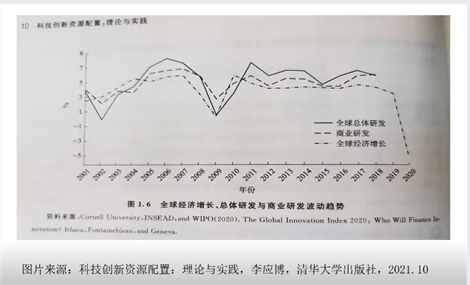
  The graph above shows that overall global R&D, business R&D and global economic growth are trending in the same direction. This leads us to ask: how can we establish a correlation between innovation and growth?
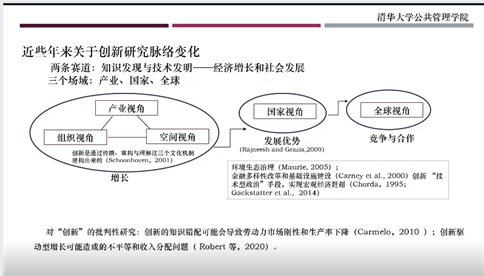
  The lineage of innovation research has evolved in recent years along two 'tracks': from a micro perspective, including knowledge discovery, technological invention and enterprise innovation; and from a macro perspective, including the impact of innovation on economic growth and social development. The impact of innovation may be positive, but there are also critical studies. For example, it has been suggested that knowledge mismatches in innovation may lead to labour market rigidities and productivity declines, and that innovation-driven growth may create inequality and income distribution problems. Three arenas of the changing vein of innovation research: 1. Industrial perspectives: i.e. organisational and spatial perspectives; 2. National perspectives: i.e. financial innovation and development advantages; 3. Global perspectives: innovation cooperation.
  A theoretical exploration of what we want to do? Does innovation necessarily imply growth? Can growth necessarily promote innovation? Economic growth is a non-linear function of time and is volatile; innovation is a cumulative process and factor combination function with lags and spillovers. In terms of spatial effects, economic growth and innovation activities may be spatially heterogeneous. So, is the study of the spatio-temporality of innovation and growth unique in different empirical scenarios?
  To answer these questions, Prof. Yingbo Li shared with us a recent article she and her research team published on Technovation: Connecting emerging industry and regional innovation system: Linkages, effect and paradigm in China
  II. Background of the study
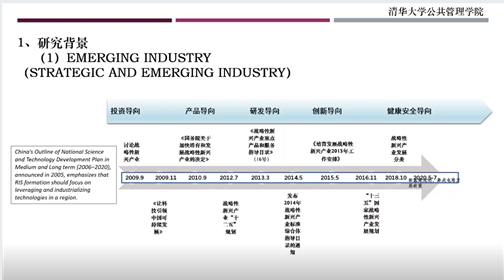
  The National Medium and Long Term Science and Technology Development Plan (2006-2020) published in 2005 emphasized that the formation of RIS should focus on the leveraging and industrialization of regional technologies. The central government promulgated the Decision of the State Council on Accelerating the Cultivation and Development of Strategic Emerging Industries in 2010, followed by China's 12th Five-Year Plan for the Development of National Strategic Emerging Industries, which proposed seven types of emerging industries and required provincial governments to formulate implementation measures to accelerate the cultivation of strategic emerging industries into leading pillar industries of the local economy. This requires provincial governments to formulate implementation measures to accelerate the development of strategic emerging industries into leading pillar industries of the local economy. As such, the development of RISs has become a viable starting point for Chinese provinces to cultivate emerging industries. While research literature exists to validate the impact of RISs on emerging industries, it is of theoretical importance to accurately argue how RISs can influence different types of emerging industries with diversified mechanisms. This also has implications for regional policy makers in developing specific policy plans to support different emerging industries.
  In order to effectively implement the Decision, the National Development and Reform Commission (NDRC) has issued a Guidance Catalogue of Products and Services for Important Emerging Industries, which includes 139 major products and services in the seven emerging industries. This article follows the NDRC's SEI classification, which includes Energy Conservation and Environmental Protection (ECEP), Biomedicine (BM), New Energy (NE), New Materials (NM), New Energy Vehicles (NV), High-End Equipment (HE) and New Generation IT (NIT). In fact, SEI has become a driving force in the transformation and upgrading of Chinese provincial industries.
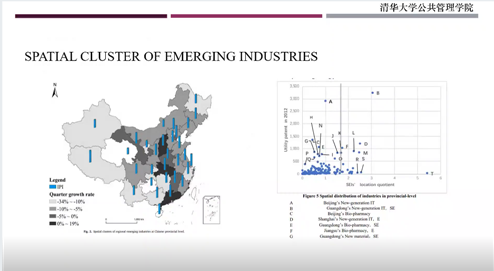
  A number of regions in China have had a strong track record in promoting the growth of strategic emerging industries since 2010. The map above shows the spatial clustering of emerging industries in mainland China.
  III. Review of the literature
  (i) Regional Innovation Systems
  Regional innovation systems (RIS) focus on localised networks of public and private sector actors and institutions whose activities and interactions generate, import, modify and disseminate new technologies (Cantwell and Iammarino, 2003; Rehfeld and Terstriep, 2019). Definitions of regions can vary, from cities to supranational territories with administrative power or socio-economic links (Rehfeld and Terstriep, 2019). We view a regional innovation system (RIS) as an organic system of innovation actors where innovation resources, innovation mechanisms and innovation outputs are set within the confines of an administrative power unit (CASTD, 2015).
  (ii) Industrial growth: definitions and metric dimensions
  The complexity of industrial growth has been extensively explored in the economic literature. In recent years, economic growth, social and environmental improvements and innovation output have been considered as key aspects of industrial growth (Li et al., 2018; Li et al., 2018; Engel and Del Palacio, 2011; Zhang et al., 2020; Li et al. 2006; Gebauer et al. 2012). Industry performance is used to measure industry growth and is multidimensional (Cooke, 1992). We will evaluate the economic growth of emerging industries in terms of three dimensions: industry size, industry profitability and industry potential.
  IV. Conceptual Framework
  This study provides an empirically useful conceptual framework linking RISs to industrial growth, based on resource dependence theory. Resource dependence theory (RDT) assumes that inter-organisational interactions are concerned with the social context of the organisation's relationship with the environment (Pfeffer and Salancik, 1978). Resource dependency and participant interaction create links between RISs and emerging industries. However, in some cases, RISs may also fail to promote the development of regional industries. the effectiveness of RISs in influencing industrial growth remains an important research question, particularly from a regional and industry perspective. Pavitt proposes three models of industrial innovation at the firm level: supply-led, production-intensive and science-based (pavitt, 1982). Castellacci (2009) examines cross-country differences in Pavitt's model of sectoral innovation and finds that there are significant differences in various technological trajectories across countries due to different national innovation systems. The analysis in this paper also shows that each emerging industry is affected by the RIS through different pathways of influence. Following this logic, the paper extends Pavitt's classification and defines an innovation paradigm for China's emerging industries.
  We constructed the theoretical analysis framework shown in Figure 1. components of the RIS are also the focus of the China Regional Innovation Capacity Report (China Academy of Science and Technology for Development, 2015) and the Regional Innovation Capacity Assessment Report (Council on Competitiveness, 2004). Three indicators of total industrial sales (by industry), average firm sales and average firm sales were used for the economic growth of emerging industries.
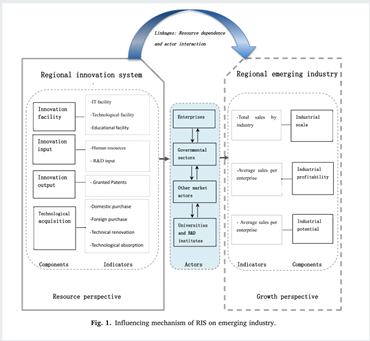
  V. Research Methodology and Analytical Results
  An error correction model (ECM) was used to test the short-term impact of the RIS on emerging industries. The entropy weighting method (EWM) was used to determine the weights of the variables. Generalised least squares was used to avoid or mitigate the heteroskedasticity problem. Unit root tests, co-integration tests and Granger causality tests were conducted respectively, and the results indicated that the data were stable and had a significant causal relationship with the dependent variable; therefore, regression analysis could be conducted.
  The results show that there is a long-term equilibrium relationship between industry growth and RIS; based on the empirical results, we summarise the impact of RIS on the growth of emerging industries, see Table 6. five emerging industries clearly show R&D-oriented characteristics. Among them, new energy vehicles and high-end equipment are R&D-oriented. The new materials industry is a mix of R&D-dominated and supplier-dominated. The biomedical industry combines supplier-led and R&D-dominated characteristics. Energy efficiency and environmental protection incorporate production intensification features into an R&D-based structure. It is also important to note that the information system factors affecting industrial growth vary, both between industries and between the short and long term. This paper classifies four innovation paradigms for SEI in China. These four paradigms are value chain driven, human capital driven, industrial upgrading driven and R&D capital driven. See Figure 3.
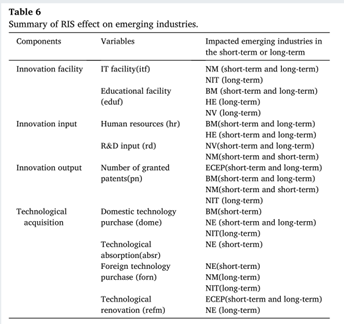
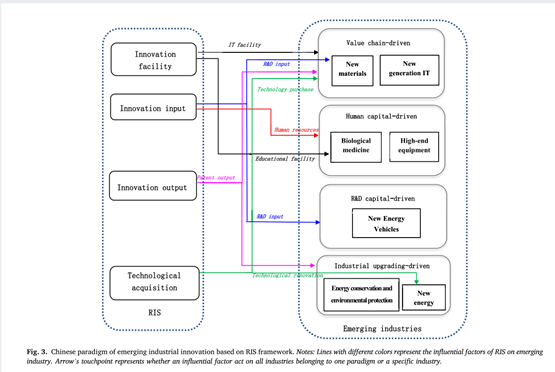
  VI. Conclusions and Policy Implications
  Policy implications of the study are mainly:
  1) Better institutional design of regional innovation systems, including high-quality, well-functioning regional markets and regional ICT environments, as well as regional labour markets, is essential for the competitiveness of new industries, especially for their long-term effects beyond the nascent stage of development;
  2) Regional government departments are committed to providing adequate and diverse regional educational resources, including increased vocational training in new industries as an effective way to motivate people to work in new industries;
  3) Government departments at all levels need to address the issue of fragmented regional labour, technology and factor markets to mitigate the spatial polarization effect of technology transfer and cross-regional resource allocation;
  4) Coordinated trust mechanisms should be established between levels of government to enhance equity in the distribution of public services between regions and to reduce disparities in the level of public services, including affordable housing, education, health care, employment, security and information infrastructure services.
  The research we have conducted can provide some insights into the analysis of the impact of RISs on traditional industries. In the future, assessing the effectiveness of RIS-related policies on industry growth in different types of industries could be further investigated.
  In this talk, Professor Li Yingbo shared some research tips for us, firstly, to analyse the literature in depth; secondly, to learn to use models to support the whole article; and thirdly, to write the article in a more practical and plain way.
  Professor Li Yingbo shared her views on time and space and her thoughts on doing research, giving us a sense of a scholar. During the lecture, Professor Li put forward her hope that Chinese scholars should convey China's development experiences and models to the world, tell the Chinese story, form our own voice internationally, form a position of Chinese scholars, and form the most essential competitiveness in the international arena. This is both a path that every scholar should think about and a direction to work towards.
  This lecture was successfully concluded.
